Related Research Articles
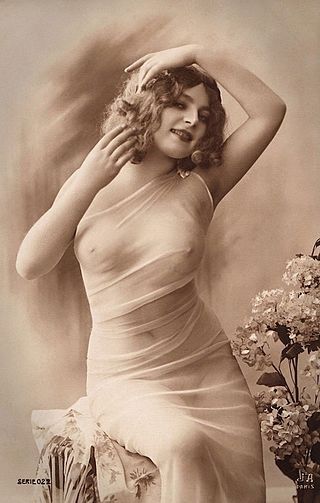
Erotica is literature or art that deals substantively with subject matter that is erotic, sexually stimulating or sexually arousing. Some critics regard pornography as a type of erotica, but many consider it to be different. Erotic art may use any artistic form to depict erotic content, including painting, sculpture, drama, film or music. Erotic literature and erotic photography have become genres in their own right. Erotica also exists in a number of subgenres including gay, lesbian, women's, bondage, monster and tentacle erotica.

Erotic art is a broad field of the visual arts that includes any artistic work intended to evoke arousal. It usually depicts human nudity or sexual activity, and has included works in various visual mediums, including drawings, engravings, films, paintings, photographs, and sculptures. Some of the earliest known works of art include erotic themes, which have recurred with varying prominence in different societies throughout history. However, it has also been widely considered taboo, with either social norms or laws restricting its creation, distribution, and possession. This is particularly the case when it is deemed pornographic, immoral, or obscene.
Jacqueline Louise Livingston was an American photographer known for her work exploring woman's role as artist and person and investigating the boundaries of intimacy and propriety.

Lesbian erotica deals with depictions in the visual arts of lesbianism, which is the expression of female-on-female sexuality. Lesbianism has been a theme in erotic art since at least the time of ancient Rome, and many regard depictions of lesbianism to be erotic.
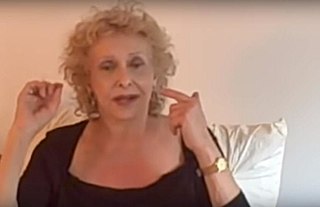
Carolee Schneemann was an American visual experimental artist, known for her multi-media works on the body, narrative, sexuality and gender. She received a B.A. in poetry and philosophy from Bard College and a Master of Fine Arts from the University of Illinois. Originally a painter in the Abstract Expressionist tradition, Schneeman was uninterested in the masculine heroism of New York painters of the time and turned to performance-based work, primarily characterized by research into visual traditions, taboos, and the body of the individual in relation to social bodies. Although renowned for her work in performance and other media, Schneemann began her career as a painter, saying: "I'm a painter. I'm still a painter and I will die a painter. Everything that I have developed has to do with extending visual principles off the canvas." Her works have been shown at the Los Angeles Museum of Contemporary Art, the Museum of Modern Art in New York, the London National Film Theatre, and many other venues.

The history of erotic depictions includes paintings, sculpture, photographs, dramatic arts, music and writings that show scenes of a sexual nature throughout time. They have been created by nearly every civilization, ancient and modern. Early cultures often associated the sexual act with supernatural forces and thus their religion is intertwined with such depictions. In Asian countries such as India, Nepal, Sri Lanka, Japan and China, representations of sex and erotic art have specific spiritual meanings within native religions. The ancient Greeks and Romans produced much art and decoration of an erotic nature, much of it integrated with their religious beliefs and cultural practices.

Ghada Amer is a contemporary artist, much of her work deals with issues of gender and sexuality. Her most notable body of work involves highly layered embroidered paintings of women's bodies referencing pornographic imagery.
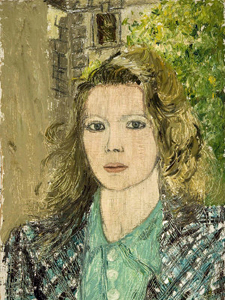
Sylvia Sleigh was a Welsh-born naturalised American realist painter who lived and worked in New York City. She is known for her role in the feminist art movement and especially for reversing traditional gender roles in her paintings of nude men, often using conventional female poses from historical paintings by male artists like Diego Vélazquez, Titian, and Jean-Auguste-Dominique Ingres. Her most well-known subjects were art critics, feminist artists, and her husband, Lawrence Alloway.

Feminist art is a category of art associated with the feminist movement of the late 1960s and 1970s. Feminist art highlights the societal and political differences women experience in their lives. The goal of this art form is to bring a positive and understanding change to the world, leading to equality or liberation. Media used range from traditional art forms, such as painting, to more unorthodox methods such as performance art, conceptual art, body art, craftivism, video, film, and fiber art. Feminist art has served as an innovative driving force toward expanding the definition of art by incorporating new media and a new perspective.
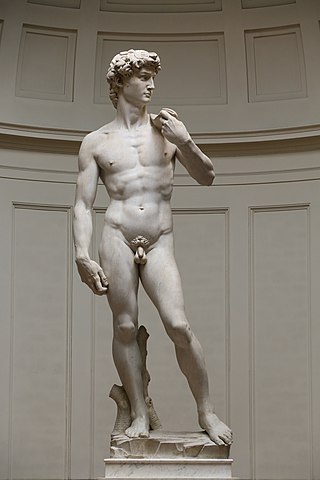
The nude, as a form of visual art that focuses on the unclothed human figure, is an enduring tradition in Western art. It was a preoccupation of Ancient Greek art, and after a semi-dormant period in the Middle Ages returned to a central position with the Renaissance. Unclothed figures often also play a part in other types of art, such as history painting, including allegorical and religious art, portraiture, or the decorative arts. From prehistory to the earliest civilizations, nude female figures were generally understood to be symbols of fertility or well-being.
SOHO20 Artists, Inc., known as SOHO20 Gallery, was founded in 1973 by a group of women artists intent on achieving professional excellence in an industry where there was a gross lack of opportunities for women to succeed. SOHO20 was one of the first galleries in Manhattan to showcase the work of an all-woman membership and most of the members joined the organization as emerging artists. These artists were provided with exhibition opportunities that they could not find elsewhere.
Anita Slavin Arkin Steckel was an American feminist artist known for paintings and photomontages with sexual imagery. She was also the founder of the arts organization "The Fight Censorship Group", whose other members included Hannah Wilke, Louise Bourgeois, Judith Bernstein, Martha Edelheit, Eunice Golden, Juanita McNeely, Barbara Nessim, Anne Sharpe and Joan Semmel.

Joan Semmel is an American feminist painter, professor, and writer. She is best known for her large-scale naturalistic nude self portraits as seen from her perspective looking down.
Martha Nilsson Edelheit, also known as Martha Ross Edelheit, is an American-born artist currently living in Sweden. She is known for her feminist art of the 1960s and 1970s, which focuses on erotic nudes.
Monica Majoli is an American artist whose artwork examines the relationship between physicality and consciousness expressed through the documentary sexual image. Her work explores intimacy through sexuality, and some aspects of alternative lifestyles such as BDSM.
Juanita McNeely was an American feminist artist known for her bold works that illustrate the female experience in her nude figurative paintings, prints, paper cut-outs, and ceramic pieces. Feminist emotional elements in her work include the portrayal of female experiences such as abortion, rape, and menstruation. Her recurring health problems and expressive figurative compositions have prompted comparisons to Frida Kahlo. According to McNeely, "we as women must continue the struggle to hold on to our rights, or let the children lead the way."

In feminist theory, the male gaze is the act of depicting women and the world in the visual arts and in literature from a masculine, heterosexual perspective that presents and represents women as sexual objects for the pleasure of the heterosexual male viewer. In the visual and aesthetic presentations of narrative cinema, the male gaze has three perspectives: that of the man behind the camera, that of the male characters within the film's cinematic representations; and that of the spectator gazing at the image.
Cynthia Mailman is an American painter and educator. She is known for figurative and landscape works done in a "cool, pared-down" style. Her early paintings were presented from a perspective inside the artist's VW van, looking outward, and include mirrors, wipers or other interior elements against the exterior landscape. By doing this, Mailman put the observer in the driver's seat, which is also the artist's point of view. According to Lawrence Alloway, "The interplay of directional movement and expanding space is a convincing expansion of the space of landscape painting".
Angela Fraleigh is a contemporary American artist. Her oil and mixed media paintings explore themes such as gender, sexuality, femininity, and power dynamics, in a style that weaves together realism, abstraction, and classical influences.
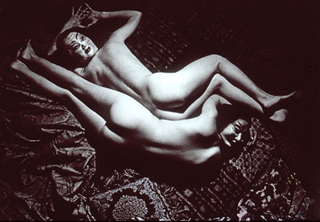
Carole Harmel is an American artist and photographer, who gained recognition for her provocative images of nudes in the 1970s and 1980s and still lifes combining photography with short narratives, wordplay and mixed media. Fundamental to Harmel's work is a questioning of reality and photographic conventions, a penchant for surrealism, and humor. The New Art Examiner described her nudes as having a "startling, queasy impact," "rich in ambiguity, discomforting in content." About her still lifes, critic Michael Weinstein wrote, "sophisticated academic criticism is fused with love of color and visual form to create images at once conceptually engaging and perceptually arresting."
References
- 1 2 "Parrish East End Stories: Artists of the East End". parrishart.org. Archived from the original on 18 October 2016. Retrieved 25 February 2018.
- 1 2 3 4 5 Levin, Gail (Fall 2007). "Censorship, Politics and Sexual Imagery in the Work of Jewish-American Feminist Artists". Nashim: A Journal of Jewish Women's Studies & Gender Issues (14): 63–96. doi:10.2979/nas.2007.-.14.63. S2CID 146313277.
- 1 2 3 4 "Feminist Art Base: Eunice Golden". www.brooklynmuseum.org. Retrieved 25 February 2018.
- ↑ Ault, Julie (ed.). Alternative New York, 1965-1985: A Cultural Politics Book for the Social Text Collective. Minneapolis: University of Minnesota Press. pp. 28–29.
- ↑ "Anita Steckel: Fighting Censorship and Double Standards". Broad Strokes: National Museum of Women in the Arts. Archived from the original on 7 March 2016. Retrieved 25 February 2018.
- 1 2 Butler, Cornelia H., ed. (2007). WACK! Art and the Feminist Revolution. Los Angeles: Museum of Contemporary Art. ISBN 9780914357995.
- ↑ Broude, Norma; Garrard, Mary D., eds. (1994). The Power of Feminist Art: The American Movement of the 1970s, History and Impact. New York: Harry N. Abrams, Inc.
- ↑ "Eunice Golden, CV" (PDF). www.brooklynmuseum.org. Retrieved 25 February 2018.
- ↑ Cotter, Holland (11 April 2003). "Art In Review: Eunice Golden". New York Times. Retrieved 5 March 2016.
- ↑ Lavin, Talia (13 February 2015). "10 Amazing Female Artists and Their Male Muses". The Huffington Post. Retrieved 25 February 2018.
- ↑ Heinemann, Susan (March 1974). "Reviews". Artforum. 12 (7): 79–80.
- ↑ Frank, Peter (13 December 1973). "On Art". SoHo Weekly News .
- ↑ Ratcliff, Carter (March–April 1977). "Remarks on the Nude". Art International. 21 (2): 60–65, 73.
- ↑ Davidov, Judith Fryer (1998). Women's Camera Work: Self/Body/Other in American Visual Culture. Duke University Press. ISBN 0822320673.
- ↑ Moore, Alan (March 1975). "Reviews". Artforum. 13 (7): 73.
- ↑ "The Swimmers 1992-99". www.eunicegolden.com. Retrieved 6 March 2016.
- ↑ "Women Painting Women". Modern Art Museum of Fort Worth. Retrieved 14 May 2022.